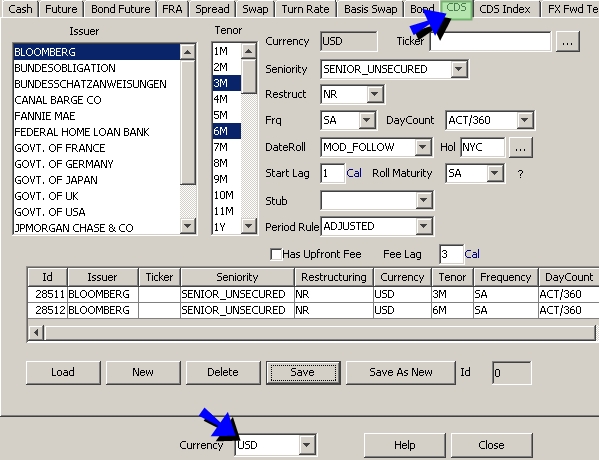CDS - Curve Underlying
Before you begin
| • | Create issuers using Configuration > Legal Data > Entities from the Calypso Navigator. |
Creating a CDS Underlying
Create an underlying representing a Credit Default Swap for an issuer and different tenors. The quotes are the market spreads for each tenor.

| » | Select a currency at the bottom of the window. |
You can click Load to load any existing underlying.
| » | Click New to create a new underlying. |
Complete the fields described below.
| » | Click Save to save the underlying. It is given a unique ID by the system, and is displayed in the table. |
The system creates quote names like "CDS.<Currency>.<Issue>.<Seniority>/<Tenor>/<Restructuring type>", and if "Has Upfront Fee" is checked additional quote names like "CDS.<Currency>.<Issue>.<Seniority>/<Tenor>/<Restructuring type>/FEE".
Example "CDS.USD.BLOOMBERG.SENIOR_UNSECURED/3M/NR".
Fields Details
| Fields | Description | ||||||||||||||||||||||||
|---|---|---|---|---|---|---|---|---|---|---|---|---|---|---|---|---|---|---|---|---|---|---|---|---|---|
|
Issuer |
Select the issuer. |
||||||||||||||||||||||||
|
Tenor |
Select one or multiple tenors. |
||||||||||||||||||||||||
|
Currency |
Displays the currency selected at the bottom of the window. |
||||||||||||||||||||||||
|
Ticker |
Optional. Click ... to select a ticker. A ticker is a combination of currency, issuer, seniority, and reference obligation used as selection criteria – You can create tickers from the Probability Curve window, or Credit Market Data window. |
||||||||||||||||||||||||
|
Seniority |
Select the seniority. |
||||||||||||||||||||||||
|
Restruct |
Select the restructuring type:
|
||||||||||||||||||||||||
|
Frq |
Select the frequency. |
||||||||||||||||||||||||
|
DayCount |
Select the day count convention. |
||||||||||||||||||||||||
|
DateRoll |
Select the date roll convention. |
||||||||||||||||||||||||
|
Hol |
Select the holiday calendar to define the business days. |
||||||||||||||||||||||||
|
Start Lag |
Define the start offset in business or calendar days. |
||||||||||||||||||||||||
|
Roll Maturity |
Roll the maturity to the 20th of the month, quarterly, or semi-annual months. |
||||||||||||||||||||||||
|
Stub |
Select the rule to apply in case of a stub period:
|
||||||||||||||||||||||||
|
Period Rule |
Select the period rule:
|
||||||||||||||||||||||||
|
Has Upfront Fee |
If you check “Has Upfront Fee,” you can enter two quotes for the curve underlying, the spread plus a fee. The second quote appears when you select the curve underlying in the curve application. Note that the second quote is currently not used by our generator. |
||||||||||||||||||||||||
|
Fee Lag |
You can enter a number of days lag for the upfront fee, and select whether the lag is business days or calendar days. |
Scheduled Task for Updating Roll Maturity
The scheduled task UPDATE_CURVE_UNDERLYING can be used for bulk updating the roll maturity of CDS curve underlyings and regenerating the curves.
Task Attributes

| • | UNDERLYING TYPE – Select the underlying type: CDS, Generic CDS, or Fixed Coupon CDS. |
| • | UNDERLYING CCY – Select a currency as needed to be updated, or leave blank to update all. |
| • | ROLL FREQUENCY – Select the roll frequency: SA or QTR. |